A decline in productivity of land
VerifiedAdded on 2022/09/15
|11
|1501
|21
AI Summary
Contribute Materials
Your contribution can guide someone’s learning journey. Share your
documents today.
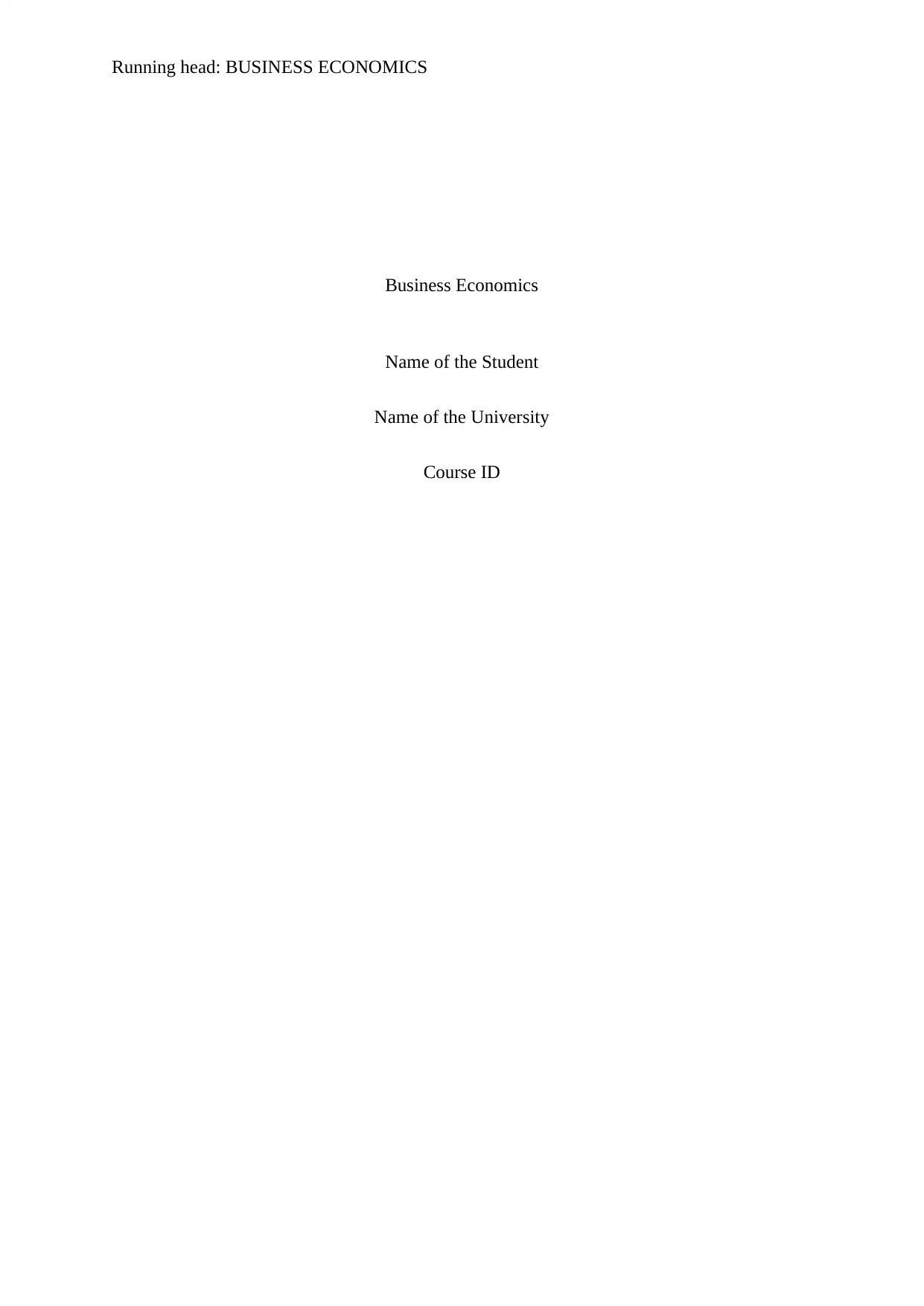
Running head: BUSINESS ECONOMICS
Business Economics
Name of the Student
Name of the University
Course ID
Business Economics
Name of the Student
Name of the University
Course ID
Secure Best Marks with AI Grader
Need help grading? Try our AI Grader for instant feedback on your assignments.
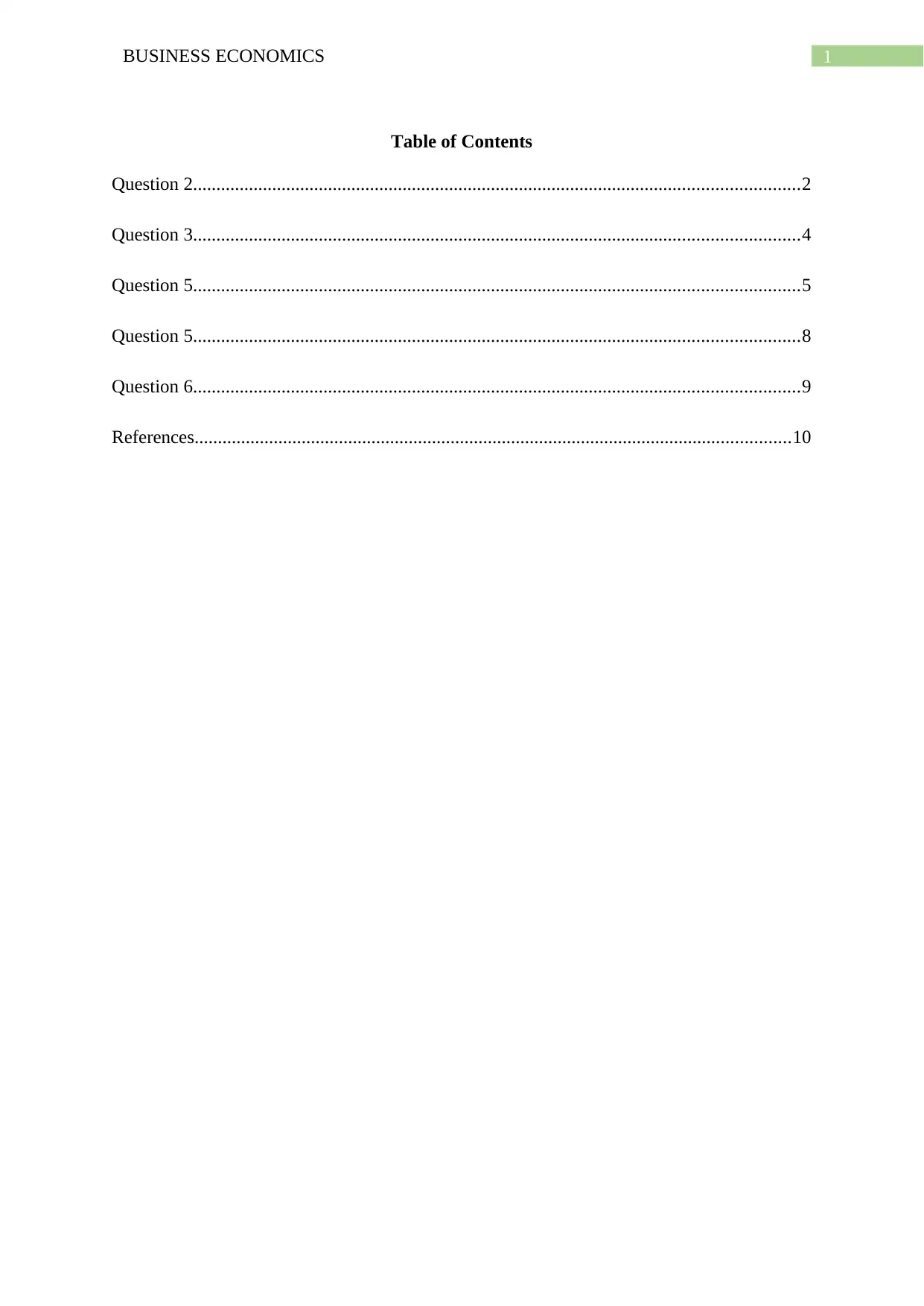
1BUSINESS ECONOMICS
Table of Contents
Question 2..................................................................................................................................2
Question 3..................................................................................................................................4
Question 5..................................................................................................................................5
Question 5..................................................................................................................................8
Question 6..................................................................................................................................9
References................................................................................................................................10
Table of Contents
Question 2..................................................................................................................................2
Question 3..................................................................................................................................4
Question 5..................................................................................................................................5
Question 5..................................................................................................................................8
Question 6..................................................................................................................................9
References................................................................................................................................10
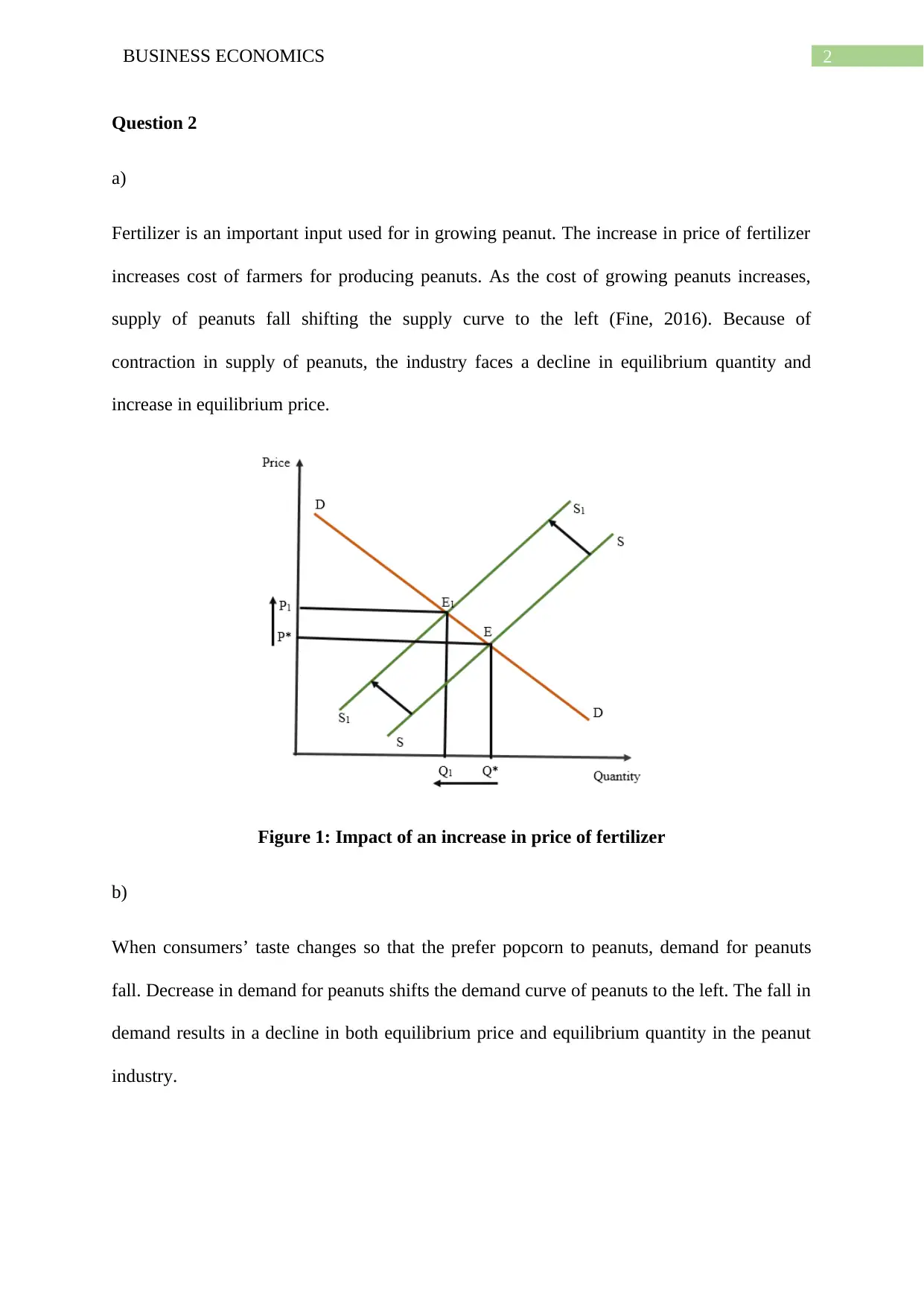
2BUSINESS ECONOMICS
Question 2
a)
Fertilizer is an important input used for in growing peanut. The increase in price of fertilizer
increases cost of farmers for producing peanuts. As the cost of growing peanuts increases,
supply of peanuts fall shifting the supply curve to the left (Fine, 2016). Because of
contraction in supply of peanuts, the industry faces a decline in equilibrium quantity and
increase in equilibrium price.
Figure 1: Impact of an increase in price of fertilizer
b)
When consumers’ taste changes so that the prefer popcorn to peanuts, demand for peanuts
fall. Decrease in demand for peanuts shifts the demand curve of peanuts to the left. The fall in
demand results in a decline in both equilibrium price and equilibrium quantity in the peanut
industry.
Question 2
a)
Fertilizer is an important input used for in growing peanut. The increase in price of fertilizer
increases cost of farmers for producing peanuts. As the cost of growing peanuts increases,
supply of peanuts fall shifting the supply curve to the left (Fine, 2016). Because of
contraction in supply of peanuts, the industry faces a decline in equilibrium quantity and
increase in equilibrium price.
Figure 1: Impact of an increase in price of fertilizer
b)
When consumers’ taste changes so that the prefer popcorn to peanuts, demand for peanuts
fall. Decrease in demand for peanuts shifts the demand curve of peanuts to the left. The fall in
demand results in a decline in both equilibrium price and equilibrium quantity in the peanut
industry.
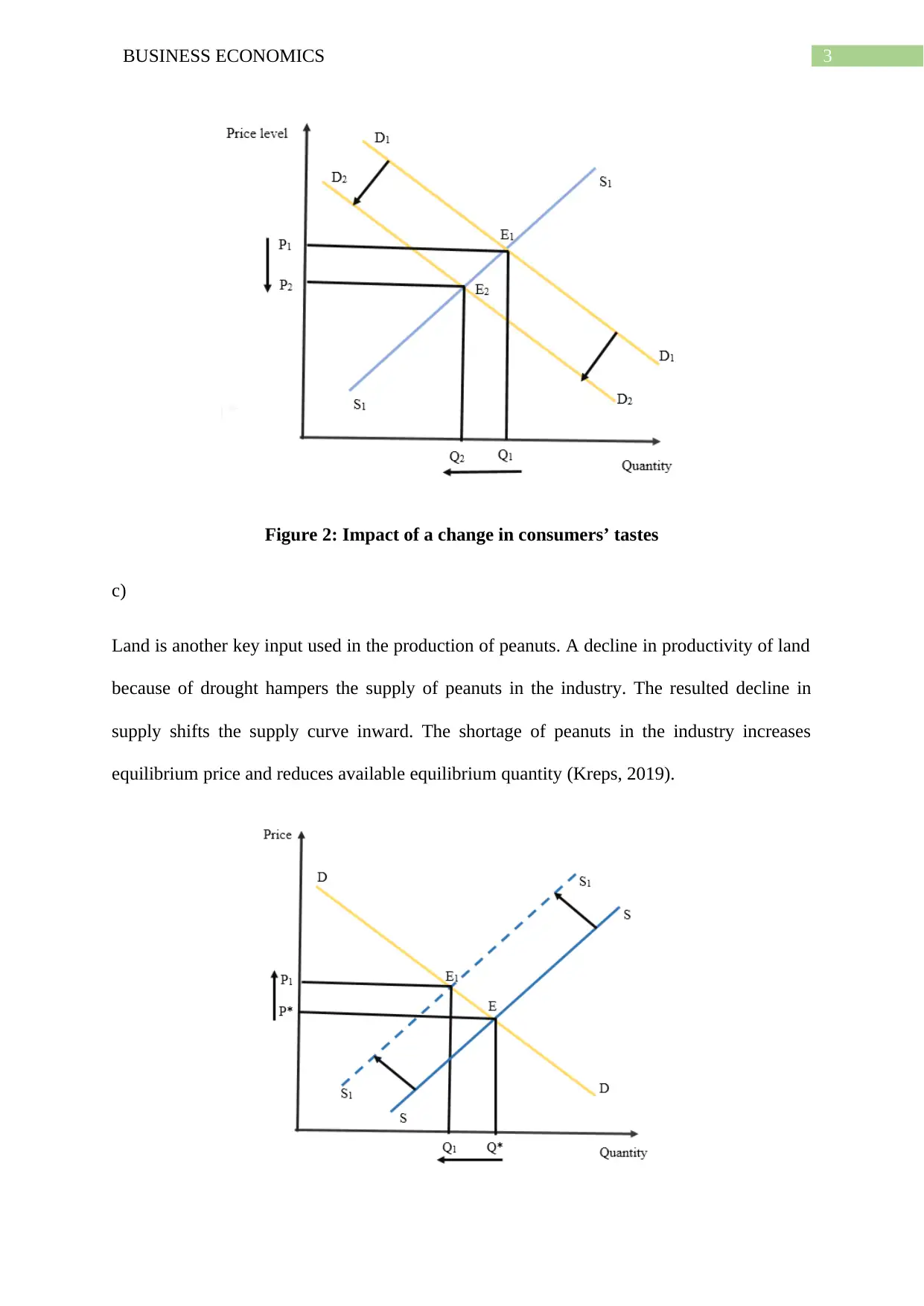
3BUSINESS ECONOMICS
Figure 2: Impact of a change in consumers’ tastes
c)
Land is another key input used in the production of peanuts. A decline in productivity of land
because of drought hampers the supply of peanuts in the industry. The resulted decline in
supply shifts the supply curve inward. The shortage of peanuts in the industry increases
equilibrium price and reduces available equilibrium quantity (Kreps, 2019).
Figure 2: Impact of a change in consumers’ tastes
c)
Land is another key input used in the production of peanuts. A decline in productivity of land
because of drought hampers the supply of peanuts in the industry. The resulted decline in
supply shifts the supply curve inward. The shortage of peanuts in the industry increases
equilibrium price and reduces available equilibrium quantity (Kreps, 2019).
Secure Best Marks with AI Grader
Need help grading? Try our AI Grader for instant feedback on your assignments.
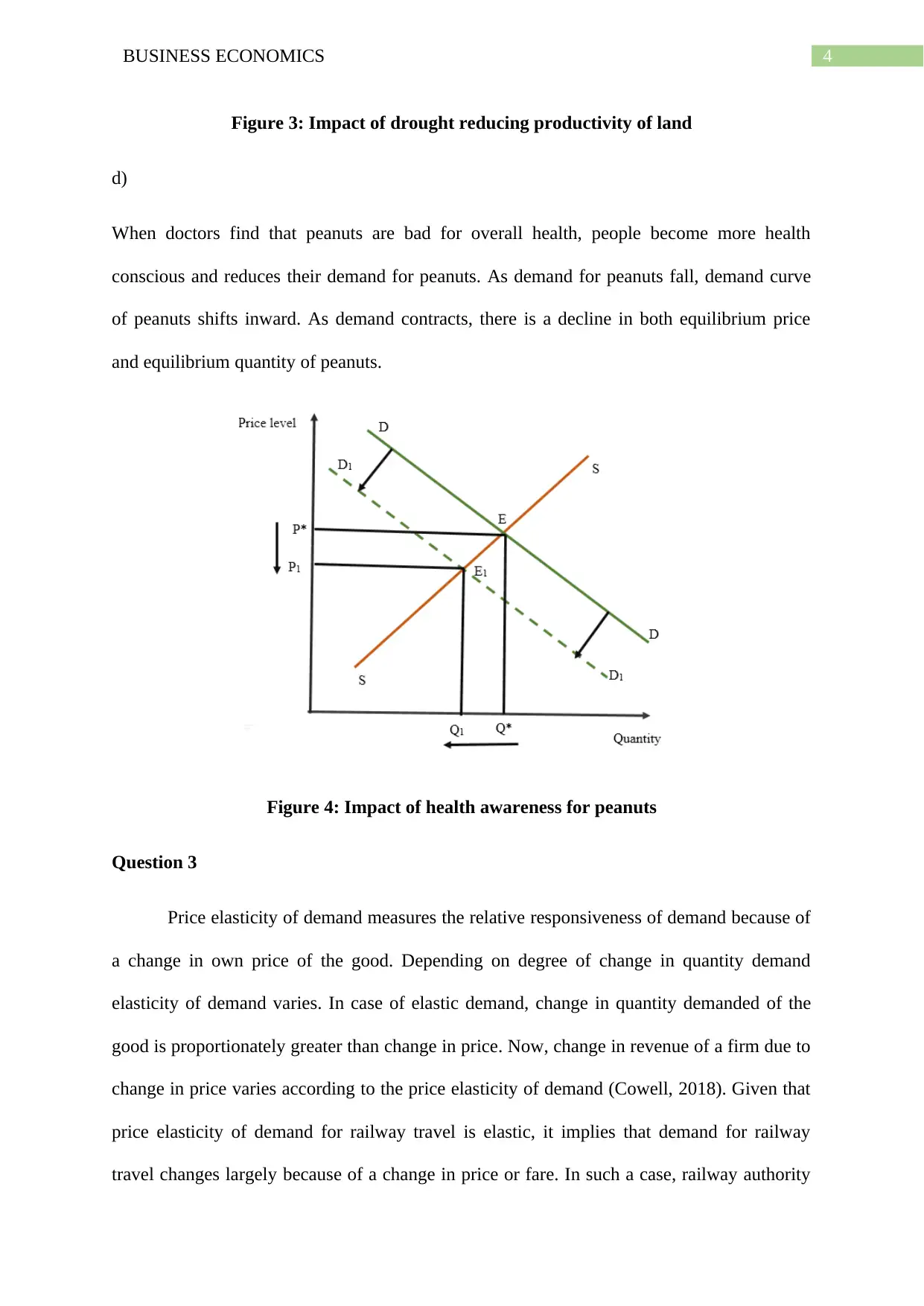
4BUSINESS ECONOMICS
Figure 3: Impact of drought reducing productivity of land
d)
When doctors find that peanuts are bad for overall health, people become more health
conscious and reduces their demand for peanuts. As demand for peanuts fall, demand curve
of peanuts shifts inward. As demand contracts, there is a decline in both equilibrium price
and equilibrium quantity of peanuts.
Figure 4: Impact of health awareness for peanuts
Question 3
Price elasticity of demand measures the relative responsiveness of demand because of
a change in own price of the good. Depending on degree of change in quantity demand
elasticity of demand varies. In case of elastic demand, change in quantity demanded of the
good is proportionately greater than change in price. Now, change in revenue of a firm due to
change in price varies according to the price elasticity of demand (Cowell, 2018). Given that
price elasticity of demand for railway travel is elastic, it implies that demand for railway
travel changes largely because of a change in price or fare. In such a case, railway authority
Figure 3: Impact of drought reducing productivity of land
d)
When doctors find that peanuts are bad for overall health, people become more health
conscious and reduces their demand for peanuts. As demand for peanuts fall, demand curve
of peanuts shifts inward. As demand contracts, there is a decline in both equilibrium price
and equilibrium quantity of peanuts.
Figure 4: Impact of health awareness for peanuts
Question 3
Price elasticity of demand measures the relative responsiveness of demand because of
a change in own price of the good. Depending on degree of change in quantity demand
elasticity of demand varies. In case of elastic demand, change in quantity demanded of the
good is proportionately greater than change in price. Now, change in revenue of a firm due to
change in price varies according to the price elasticity of demand (Cowell, 2018). Given that
price elasticity of demand for railway travel is elastic, it implies that demand for railway
travel changes largely because of a change in price or fare. In such a case, railway authority
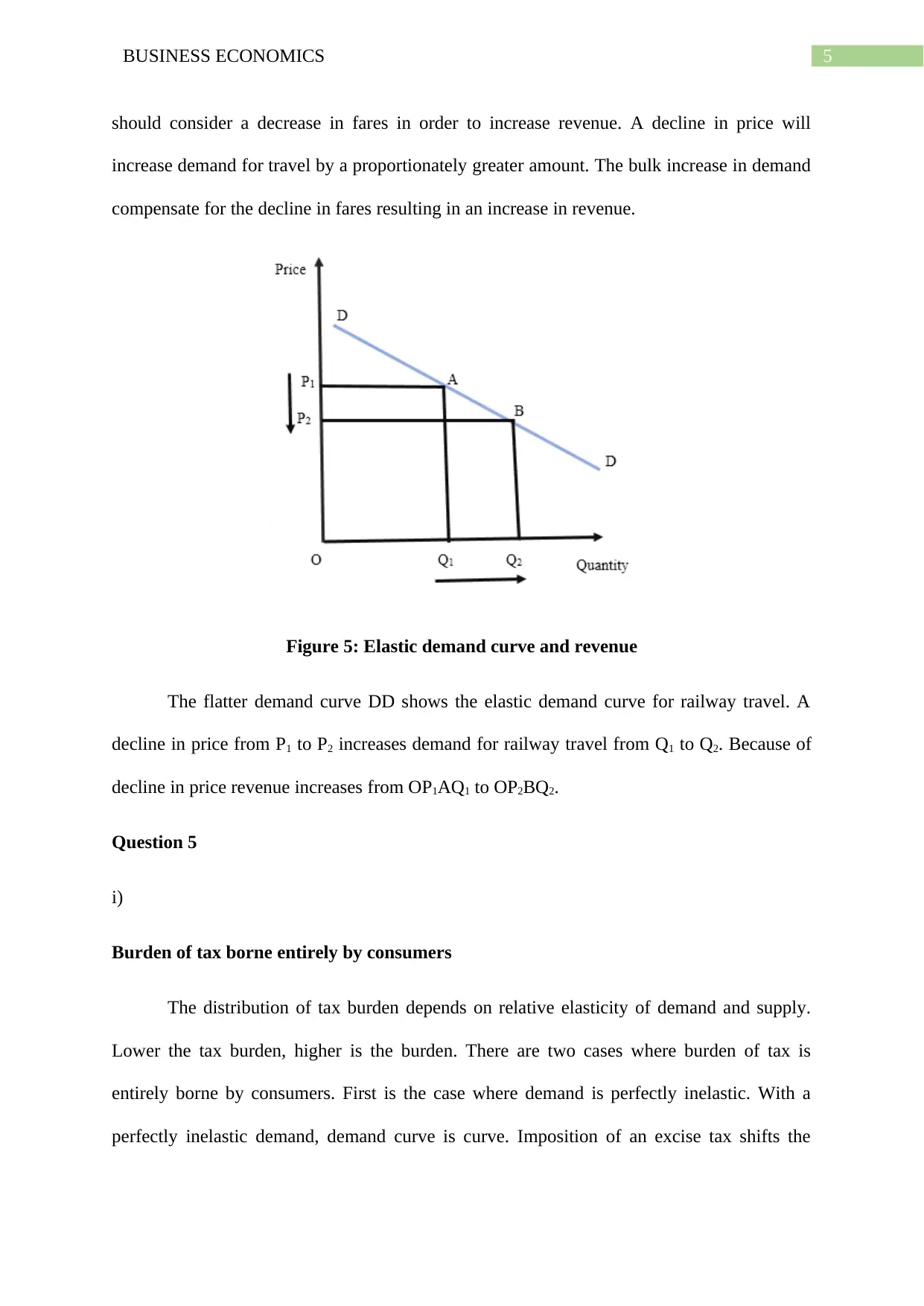
5BUSINESS ECONOMICS
should consider a decrease in fares in order to increase revenue. A decline in price will
increase demand for travel by a proportionately greater amount. The bulk increase in demand
compensate for the decline in fares resulting in an increase in revenue.
Figure 5: Elastic demand curve and revenue
The flatter demand curve DD shows the elastic demand curve for railway travel. A
decline in price from P1 to P2 increases demand for railway travel from Q1 to Q2. Because of
decline in price revenue increases from OP1AQ1 to OP2BQ2.
Question 5
i)
Burden of tax borne entirely by consumers
The distribution of tax burden depends on relative elasticity of demand and supply.
Lower the tax burden, higher is the burden. There are two cases where burden of tax is
entirely borne by consumers. First is the case where demand is perfectly inelastic. With a
perfectly inelastic demand, demand curve is curve. Imposition of an excise tax shifts the
should consider a decrease in fares in order to increase revenue. A decline in price will
increase demand for travel by a proportionately greater amount. The bulk increase in demand
compensate for the decline in fares resulting in an increase in revenue.
Figure 5: Elastic demand curve and revenue
The flatter demand curve DD shows the elastic demand curve for railway travel. A
decline in price from P1 to P2 increases demand for railway travel from Q1 to Q2. Because of
decline in price revenue increases from OP1AQ1 to OP2BQ2.
Question 5
i)
Burden of tax borne entirely by consumers
The distribution of tax burden depends on relative elasticity of demand and supply.
Lower the tax burden, higher is the burden. There are two cases where burden of tax is
entirely borne by consumers. First is the case where demand is perfectly inelastic. With a
perfectly inelastic demand, demand curve is curve. Imposition of an excise tax shifts the
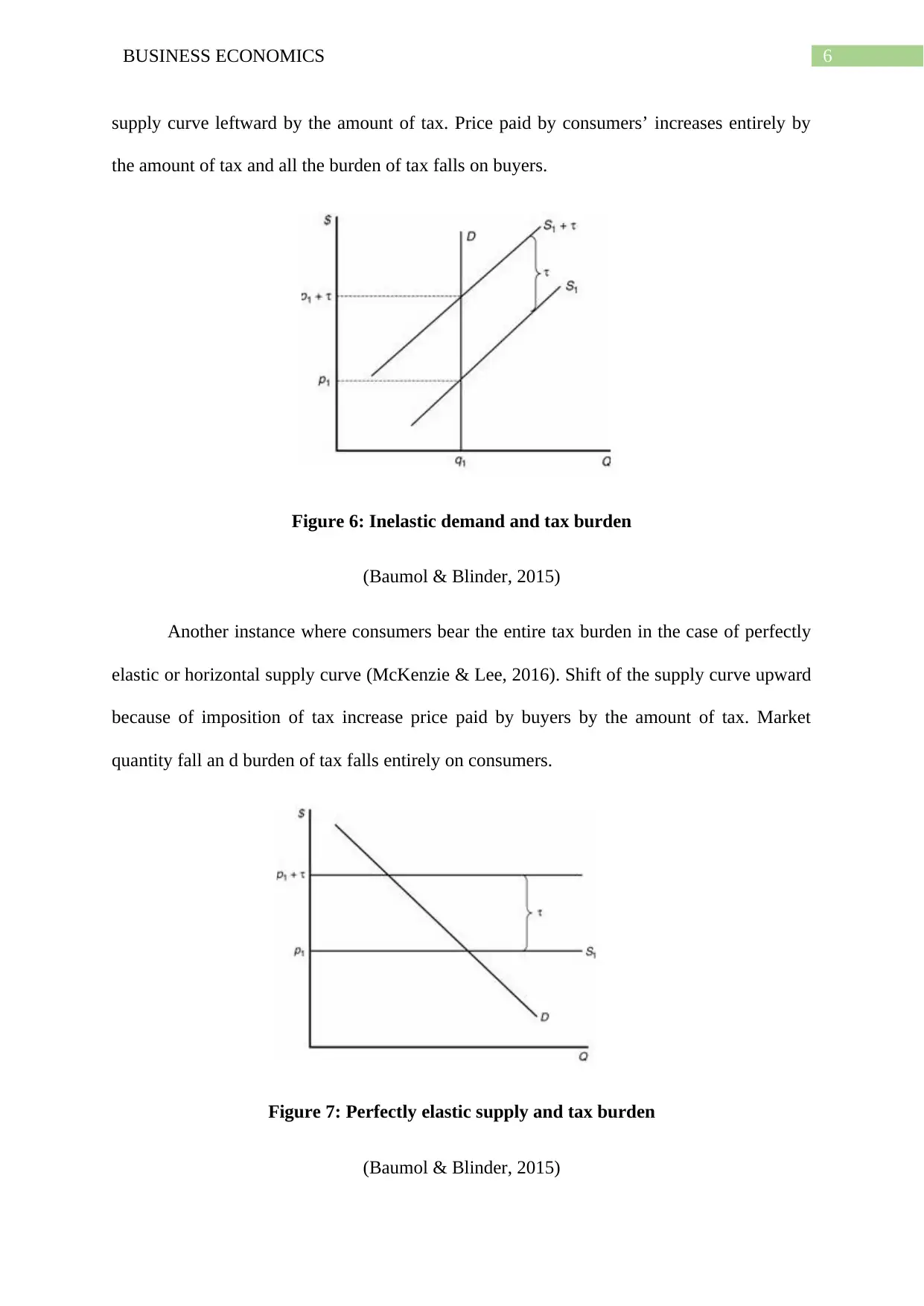
6BUSINESS ECONOMICS
supply curve leftward by the amount of tax. Price paid by consumers’ increases entirely by
the amount of tax and all the burden of tax falls on buyers.
Figure 6: Inelastic demand and tax burden
(Baumol & Blinder, 2015)
Another instance where consumers bear the entire tax burden in the case of perfectly
elastic or horizontal supply curve (McKenzie & Lee, 2016). Shift of the supply curve upward
because of imposition of tax increase price paid by buyers by the amount of tax. Market
quantity fall an d burden of tax falls entirely on consumers.
Figure 7: Perfectly elastic supply and tax burden
(Baumol & Blinder, 2015)
supply curve leftward by the amount of tax. Price paid by consumers’ increases entirely by
the amount of tax and all the burden of tax falls on buyers.
Figure 6: Inelastic demand and tax burden
(Baumol & Blinder, 2015)
Another instance where consumers bear the entire tax burden in the case of perfectly
elastic or horizontal supply curve (McKenzie & Lee, 2016). Shift of the supply curve upward
because of imposition of tax increase price paid by buyers by the amount of tax. Market
quantity fall an d burden of tax falls entirely on consumers.
Figure 7: Perfectly elastic supply and tax burden
(Baumol & Blinder, 2015)
Paraphrase This Document
Need a fresh take? Get an instant paraphrase of this document with our AI Paraphraser
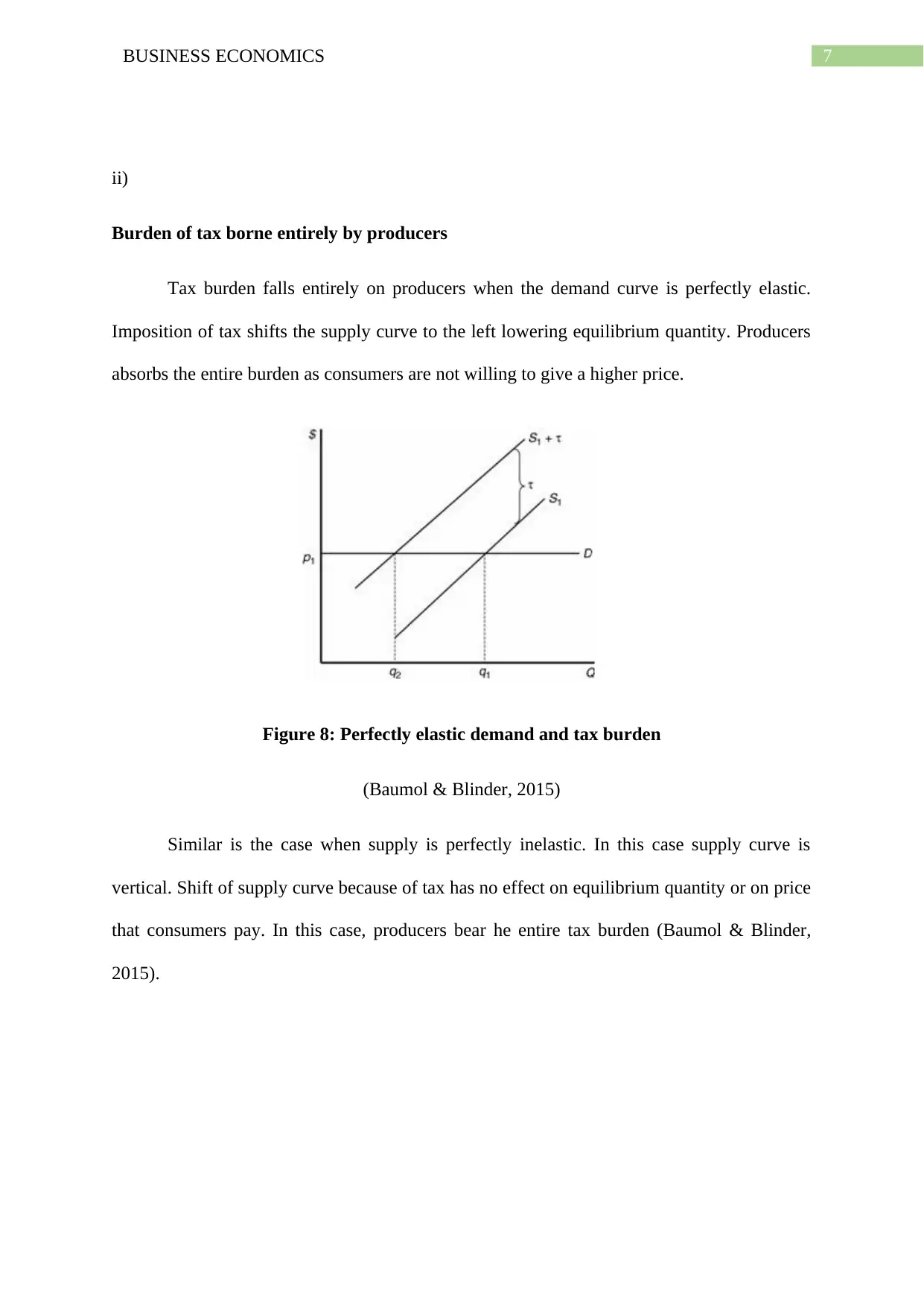
7BUSINESS ECONOMICS
ii)
Burden of tax borne entirely by producers
Tax burden falls entirely on producers when the demand curve is perfectly elastic.
Imposition of tax shifts the supply curve to the left lowering equilibrium quantity. Producers
absorbs the entire burden as consumers are not willing to give a higher price.
Figure 8: Perfectly elastic demand and tax burden
(Baumol & Blinder, 2015)
Similar is the case when supply is perfectly inelastic. In this case supply curve is
vertical. Shift of supply curve because of tax has no effect on equilibrium quantity or on price
that consumers pay. In this case, producers bear he entire tax burden (Baumol & Blinder,
2015).
ii)
Burden of tax borne entirely by producers
Tax burden falls entirely on producers when the demand curve is perfectly elastic.
Imposition of tax shifts the supply curve to the left lowering equilibrium quantity. Producers
absorbs the entire burden as consumers are not willing to give a higher price.
Figure 8: Perfectly elastic demand and tax burden
(Baumol & Blinder, 2015)
Similar is the case when supply is perfectly inelastic. In this case supply curve is
vertical. Shift of supply curve because of tax has no effect on equilibrium quantity or on price
that consumers pay. In this case, producers bear he entire tax burden (Baumol & Blinder,
2015).
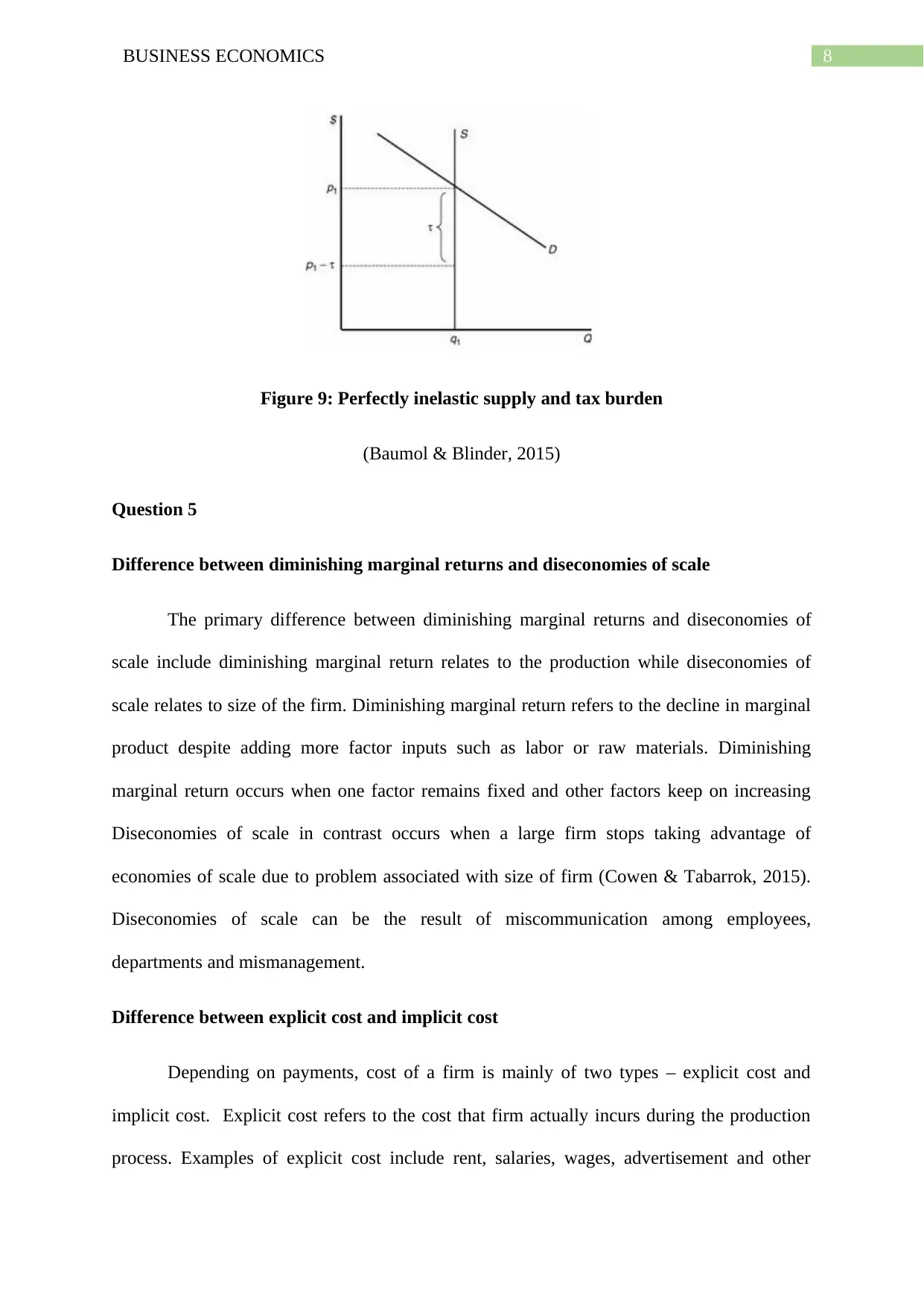
8BUSINESS ECONOMICS
Figure 9: Perfectly inelastic supply and tax burden
(Baumol & Blinder, 2015)
Question 5
Difference between diminishing marginal returns and diseconomies of scale
The primary difference between diminishing marginal returns and diseconomies of
scale include diminishing marginal return relates to the production while diseconomies of
scale relates to size of the firm. Diminishing marginal return refers to the decline in marginal
product despite adding more factor inputs such as labor or raw materials. Diminishing
marginal return occurs when one factor remains fixed and other factors keep on increasing
Diseconomies of scale in contrast occurs when a large firm stops taking advantage of
economies of scale due to problem associated with size of firm (Cowen & Tabarrok, 2015).
Diseconomies of scale can be the result of miscommunication among employees,
departments and mismanagement.
Difference between explicit cost and implicit cost
Depending on payments, cost of a firm is mainly of two types – explicit cost and
implicit cost. Explicit cost refers to the cost that firm actually incurs during the production
process. Examples of explicit cost include rent, salaries, wages, advertisement and other
Figure 9: Perfectly inelastic supply and tax burden
(Baumol & Blinder, 2015)
Question 5
Difference between diminishing marginal returns and diseconomies of scale
The primary difference between diminishing marginal returns and diseconomies of
scale include diminishing marginal return relates to the production while diseconomies of
scale relates to size of the firm. Diminishing marginal return refers to the decline in marginal
product despite adding more factor inputs such as labor or raw materials. Diminishing
marginal return occurs when one factor remains fixed and other factors keep on increasing
Diseconomies of scale in contrast occurs when a large firm stops taking advantage of
economies of scale due to problem associated with size of firm (Cowen & Tabarrok, 2015).
Diseconomies of scale can be the result of miscommunication among employees,
departments and mismanagement.
Difference between explicit cost and implicit cost
Depending on payments, cost of a firm is mainly of two types – explicit cost and
implicit cost. Explicit cost refers to the cost that firm actually incurs during the production
process. Examples of explicit cost include rent, salaries, wages, advertisement and other
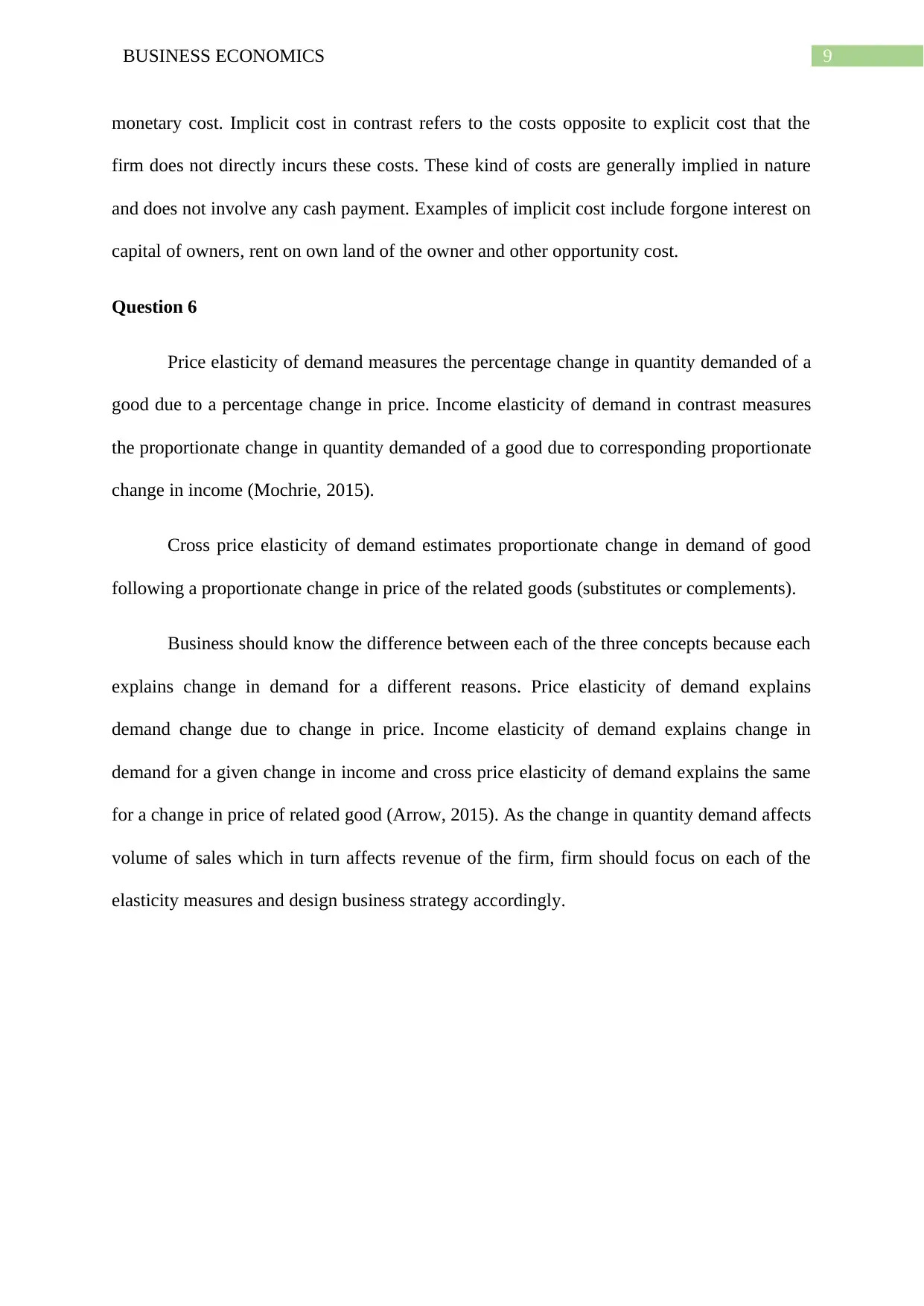
9BUSINESS ECONOMICS
monetary cost. Implicit cost in contrast refers to the costs opposite to explicit cost that the
firm does not directly incurs these costs. These kind of costs are generally implied in nature
and does not involve any cash payment. Examples of implicit cost include forgone interest on
capital of owners, rent on own land of the owner and other opportunity cost.
Question 6
Price elasticity of demand measures the percentage change in quantity demanded of a
good due to a percentage change in price. Income elasticity of demand in contrast measures
the proportionate change in quantity demanded of a good due to corresponding proportionate
change in income (Mochrie, 2015).
Cross price elasticity of demand estimates proportionate change in demand of good
following a proportionate change in price of the related goods (substitutes or complements).
Business should know the difference between each of the three concepts because each
explains change in demand for a different reasons. Price elasticity of demand explains
demand change due to change in price. Income elasticity of demand explains change in
demand for a given change in income and cross price elasticity of demand explains the same
for a change in price of related good (Arrow, 2015). As the change in quantity demand affects
volume of sales which in turn affects revenue of the firm, firm should focus on each of the
elasticity measures and design business strategy accordingly.
monetary cost. Implicit cost in contrast refers to the costs opposite to explicit cost that the
firm does not directly incurs these costs. These kind of costs are generally implied in nature
and does not involve any cash payment. Examples of implicit cost include forgone interest on
capital of owners, rent on own land of the owner and other opportunity cost.
Question 6
Price elasticity of demand measures the percentage change in quantity demanded of a
good due to a percentage change in price. Income elasticity of demand in contrast measures
the proportionate change in quantity demanded of a good due to corresponding proportionate
change in income (Mochrie, 2015).
Cross price elasticity of demand estimates proportionate change in demand of good
following a proportionate change in price of the related goods (substitutes or complements).
Business should know the difference between each of the three concepts because each
explains change in demand for a different reasons. Price elasticity of demand explains
demand change due to change in price. Income elasticity of demand explains change in
demand for a given change in income and cross price elasticity of demand explains the same
for a change in price of related good (Arrow, 2015). As the change in quantity demand affects
volume of sales which in turn affects revenue of the firm, firm should focus on each of the
elasticity measures and design business strategy accordingly.
Secure Best Marks with AI Grader
Need help grading? Try our AI Grader for instant feedback on your assignments.
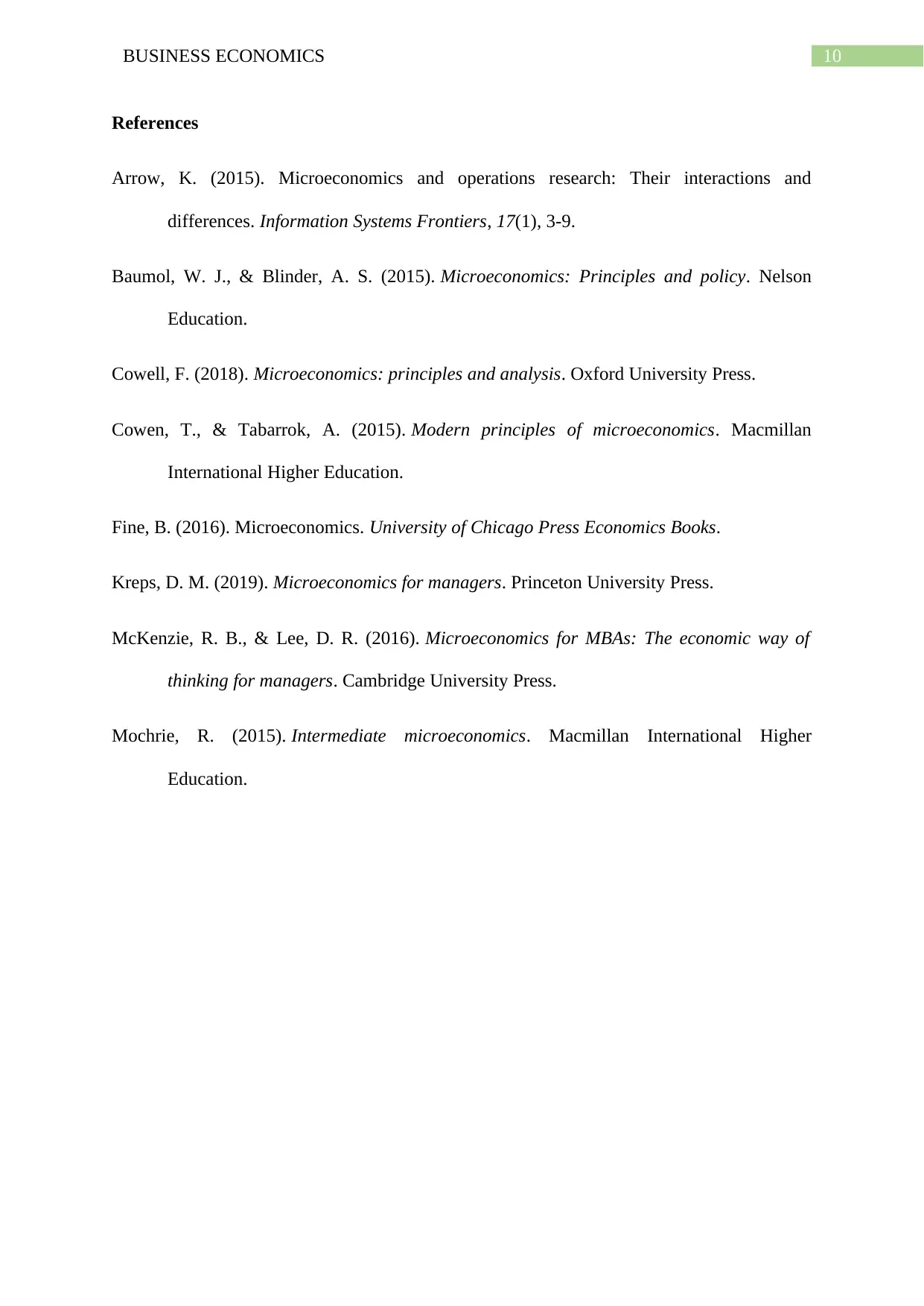
10BUSINESS ECONOMICS
References
Arrow, K. (2015). Microeconomics and operations research: Their interactions and
differences. Information Systems Frontiers, 17(1), 3-9.
Baumol, W. J., & Blinder, A. S. (2015). Microeconomics: Principles and policy. Nelson
Education.
Cowell, F. (2018). Microeconomics: principles and analysis. Oxford University Press.
Cowen, T., & Tabarrok, A. (2015). Modern principles of microeconomics. Macmillan
International Higher Education.
Fine, B. (2016). Microeconomics. University of Chicago Press Economics Books.
Kreps, D. M. (2019). Microeconomics for managers. Princeton University Press.
McKenzie, R. B., & Lee, D. R. (2016). Microeconomics for MBAs: The economic way of
thinking for managers. Cambridge University Press.
Mochrie, R. (2015). Intermediate microeconomics. Macmillan International Higher
Education.
References
Arrow, K. (2015). Microeconomics and operations research: Their interactions and
differences. Information Systems Frontiers, 17(1), 3-9.
Baumol, W. J., & Blinder, A. S. (2015). Microeconomics: Principles and policy. Nelson
Education.
Cowell, F. (2018). Microeconomics: principles and analysis. Oxford University Press.
Cowen, T., & Tabarrok, A. (2015). Modern principles of microeconomics. Macmillan
International Higher Education.
Fine, B. (2016). Microeconomics. University of Chicago Press Economics Books.
Kreps, D. M. (2019). Microeconomics for managers. Princeton University Press.
McKenzie, R. B., & Lee, D. R. (2016). Microeconomics for MBAs: The economic way of
thinking for managers. Cambridge University Press.
Mochrie, R. (2015). Intermediate microeconomics. Macmillan International Higher
Education.
1 out of 11
Related Documents
Your All-in-One AI-Powered Toolkit for Academic Success.
+13062052269
info@desklib.com
Available 24*7 on WhatsApp / Email
![[object Object]](/_next/static/media/star-bottom.7253800d.svg)
Unlock your academic potential
© 2024 | Zucol Services PVT LTD | All rights reserved.





